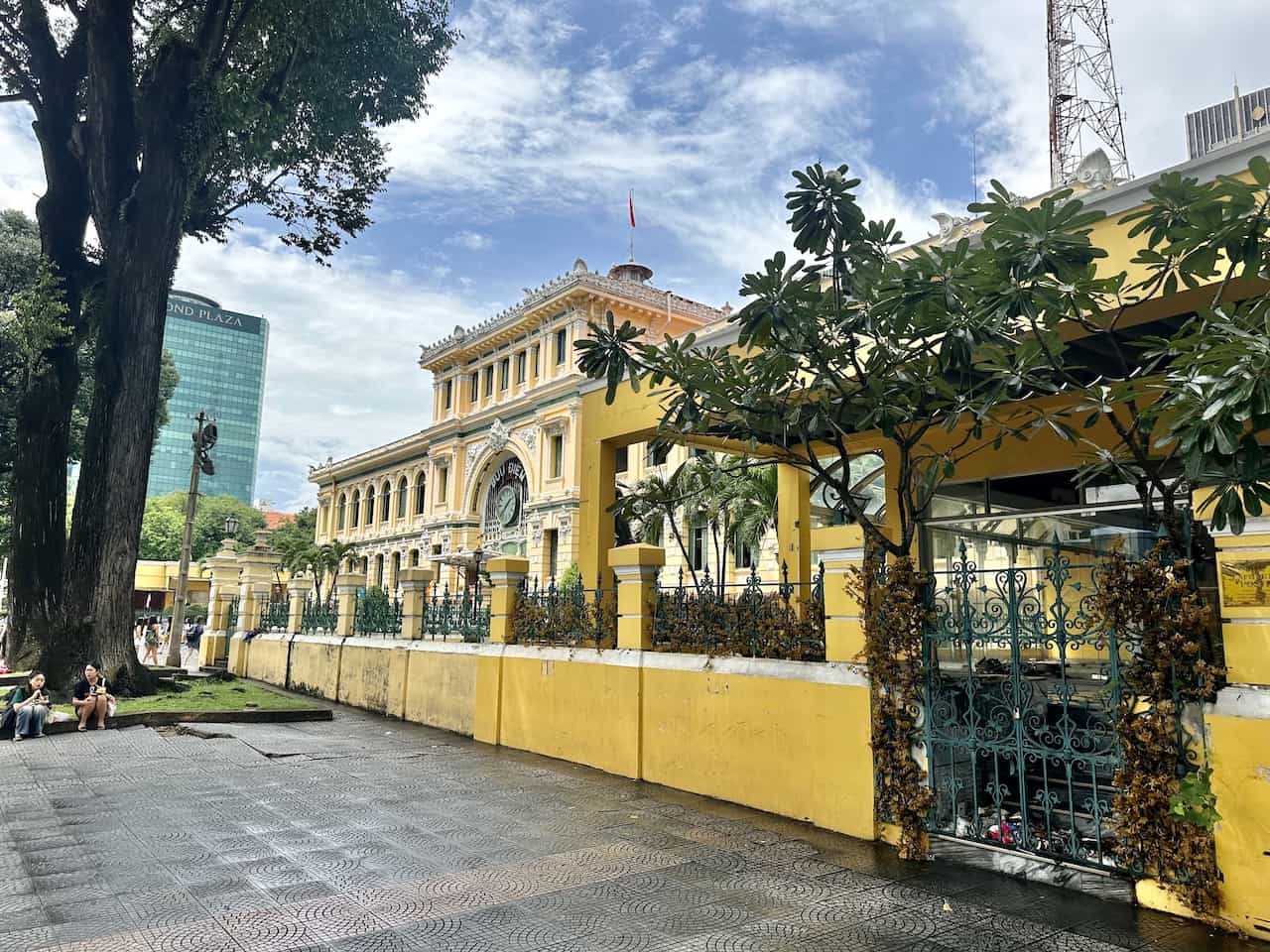24 Hours in Saigon: A Ho Chi Minh City Walking Tour

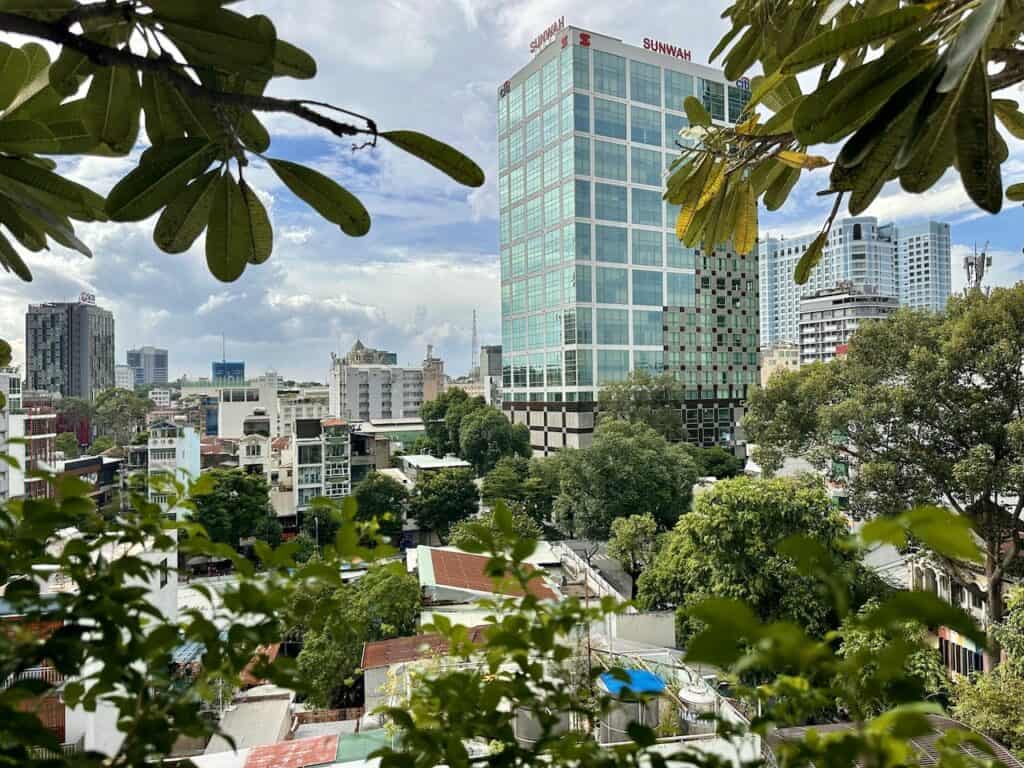
Saigon, also known as Ho Chi Minh City, is an excellent city for a self-guided walking tour. The city is rich in history, culture, and attractions, which can be easily explored on foot.
If you only have a day or two in Saigon, you can still see the city’s top sites in 24 hours!
Whether you go on a self-guided tour (itinerary below) or hire a guide (options below), here are the main reasons why a walking tour in Saigon is such a great idea:
- Compact City Center: The main tourist attractions in Saigon are relatively close to each other in the city center.
- Vibrant Street Life: Walking allows you to immerse yourself in the vibrant street life of Saigon. You can explore bustling markets, try street food, and interact with the local people who call Ho Chi Minh City “home.”
- Hidden Gems: Walking at your own pace allows you to discover hidden gems and local eateries that you might miss when traveling by other means of transportation.
- Parks and Green Spaces: Ho Chi Minh City also has several parks and green spaces, such as Tao Dan Park and Le Van Tam Park, where you can take a break from the bustling streets and enjoy some tranquility.
You can use the Table of Contents below to scroll down to the self-guided Saigon walking tour itinerary.
The Best Tours of Ho Chi Minh City
While it’s easy to take yourself on a guided walking tour of Ho Chi Minh City, a lot of people look to hire a local guide to get more information about the history and culture of Saigon.
These are a few of the best Saigon tours, each with excellent reviews:
🇻🇳 Click to Book: Private Full-Day in Saigon
- Full-day tour of Saigon’s top sites for just your group
🇻🇳 Click to Book: Ho Chi Minh Half-Day
- Small group, four-hour tour of Saigon
🇻🇳 Click to Book: Private Tour from Port
- For cruise ship passengers, a shore excursion to the city’s landmarks
🇻🇳 Click to Book: Saigon’s Top Photo Spots
- Private tour of Ho Chi Minh City’s most photogenic sites.
Tours Near Saigon
🇻🇳 Click to Book: Mangrove Forest & Wildlife
- Private, full-day tour of UNESCO Biosphere Reserve
🇻🇳 Click to Book: Cu Chi Tunnels & Mekong River
- Small group, full-day tour of the Mekong Delta and wartime tunnels.
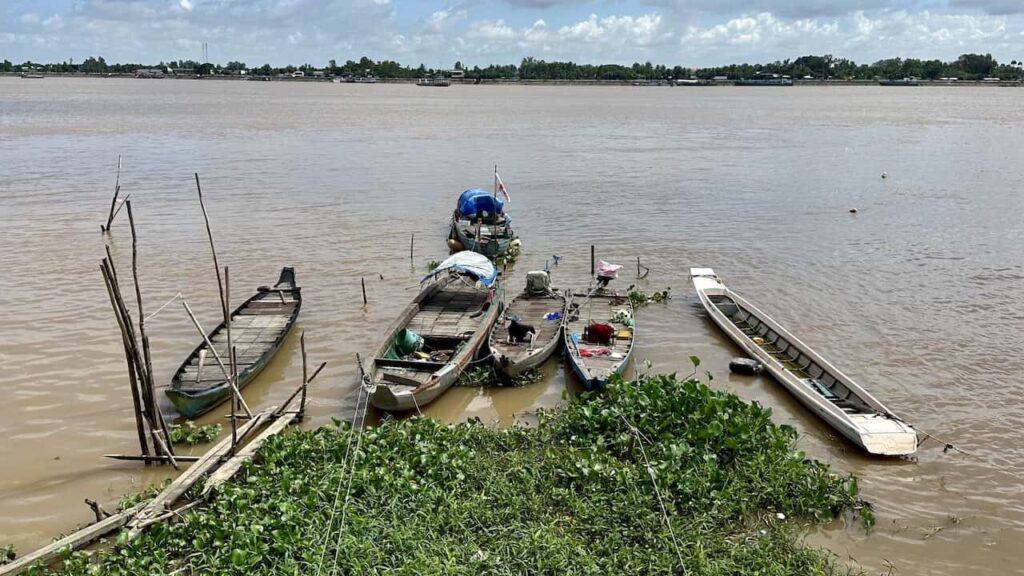
Where to Stay in Saigon
Most visitors to Ho Chi Minh City stay in what’s known as District 1. The hotels here are within a walkable distance of all of the main historic and cultural landmarks in the city.
You can use this interactive map to plug in your dates to see which hotels are available. It’ll include the best prices from sites like Hotels, Booking, and Expedia, plus rentals on VRBO:
The Au Lac Charner
Ho Chi Minh City is home to massive modern hotels, plus smaller boutique hotels, like the Au Lac Charner.
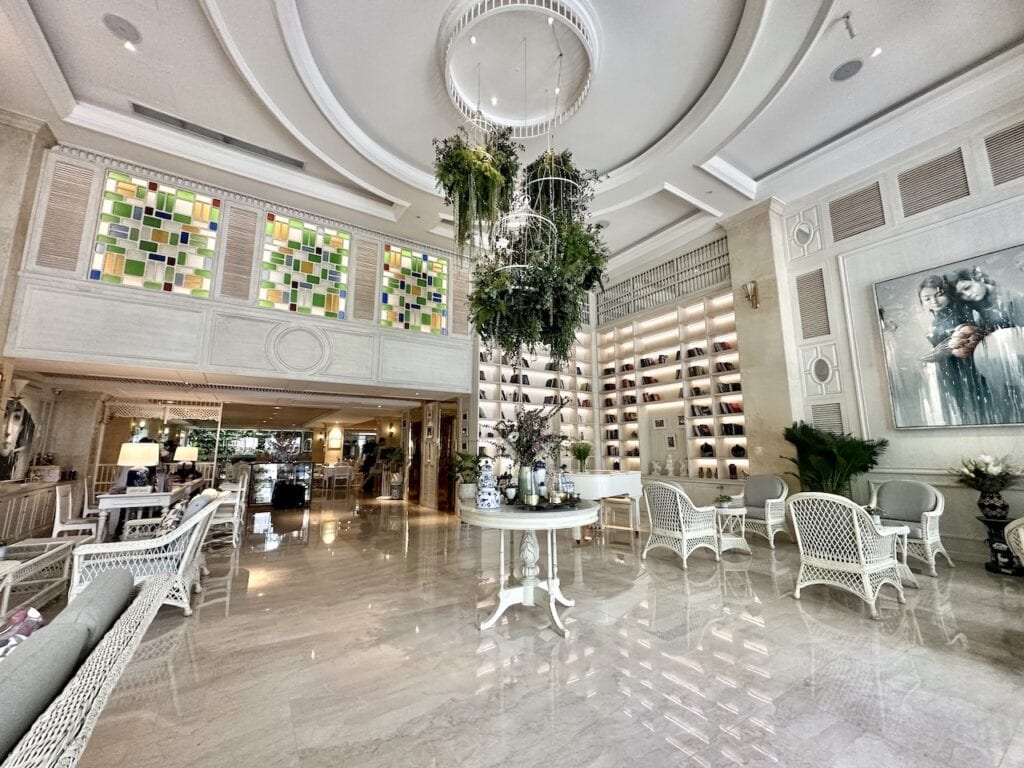
Its decor is modeled after the elegant French Colonial tea houses. While the Au Lac is right in the hustle and bustle of Saigon’s District 1, its rooftop pool and bar also provide an escape from the busy streets below.
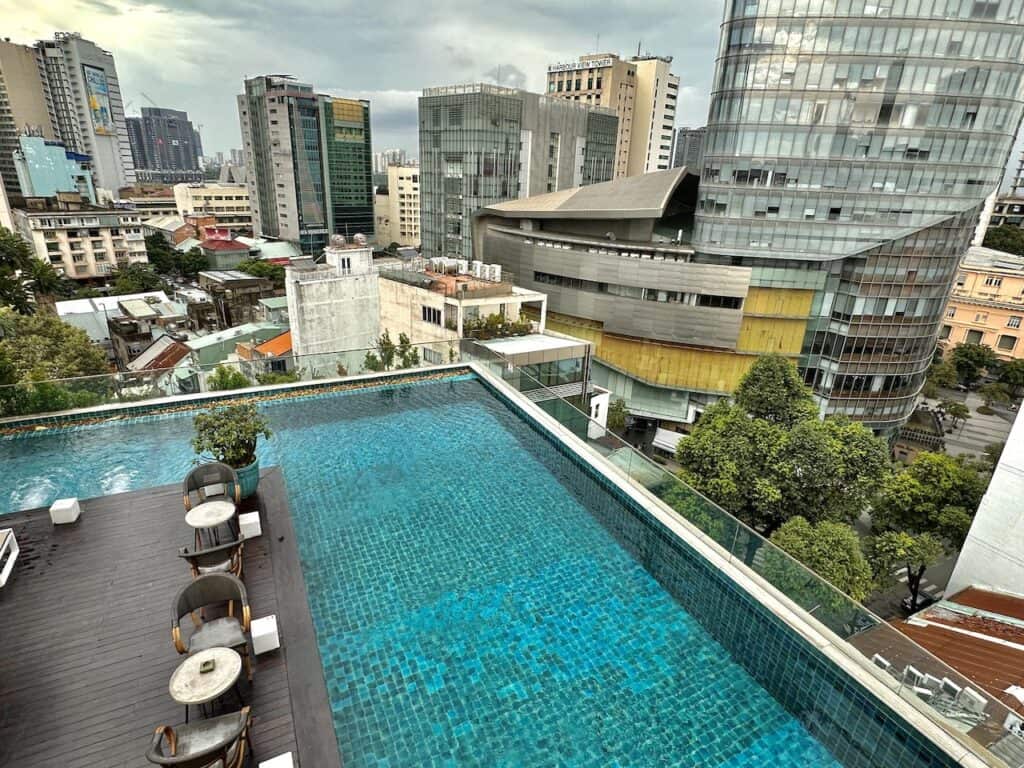
24 Hours in Saigon: Walking Tour Itinerary
The most famous sites in Saigon are all very close to each other. They’re all either free, or they come with just a small ticket fee.
Here’s an example of a walking tour itinerary I’d follow:
Walking Tour Start: Independence Palace
- Enter on the northeast side of the complex
- Price: 65,000 VD ($3 USD)
- Hours: Daily 8:00 am – 4:30 pm
- Website: Click here
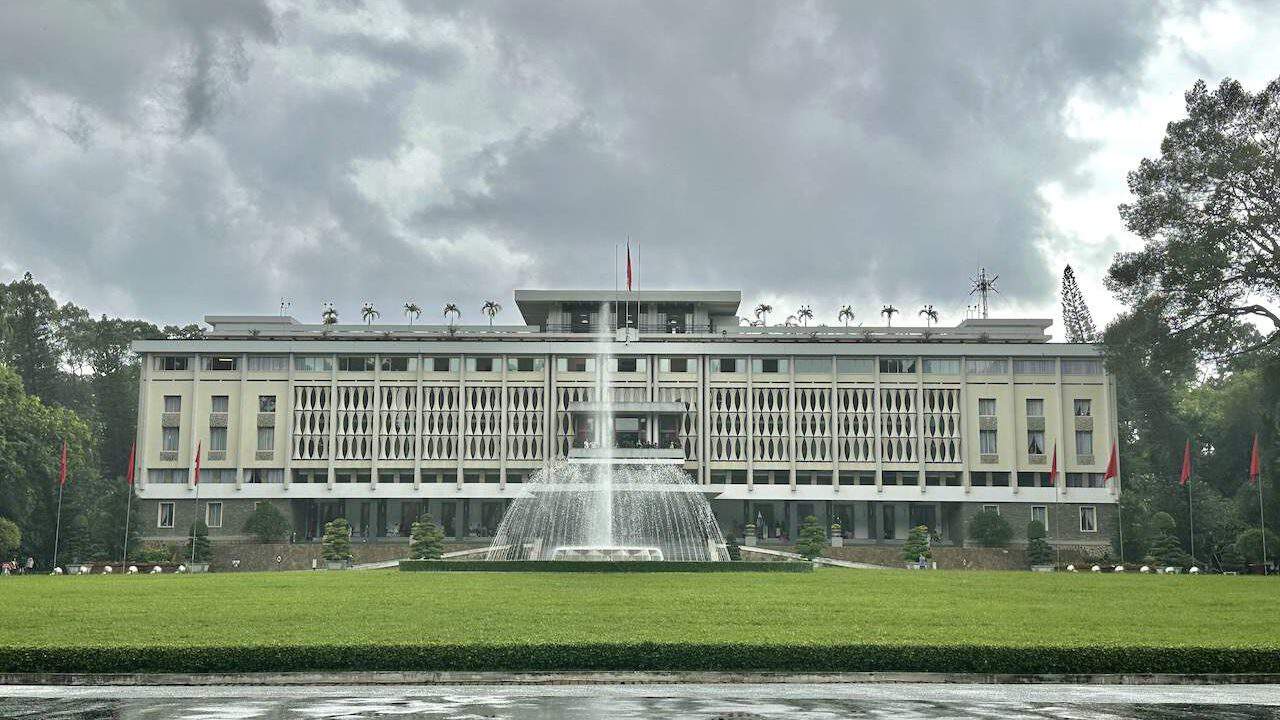
Independence Palace is a historical site and an architectural marvel. It provides visitors with a unique opportunity to delve into Vietnam’s history, particularly the events leading up to the reunification of North and South Vietnam.
The palace, also known as Reunification Palace (Dinh Độc Lập or Dinh Thống Nhất), and its grounds are open to the public.
- Palace Grounds: Start by exploring the park surrounding the palace.
- Historical Exhibitions: Independence Palace offers several rooms and areas that are open to the public and provide insight into its history. These areas include historic meeting rooms (still decked out in 1960s decor), and the living quarters of the president.
- Basement Bunker: Descend into the palace’s basement to see the war rooms and tunnels.
- Roof Terrace: Climb to the roof terrace to enjoy panoramic views of the surrounding area.
The palace grounds are also home to several historic pieces of military equipment. They’re parked under a shady canopy of large old trees.
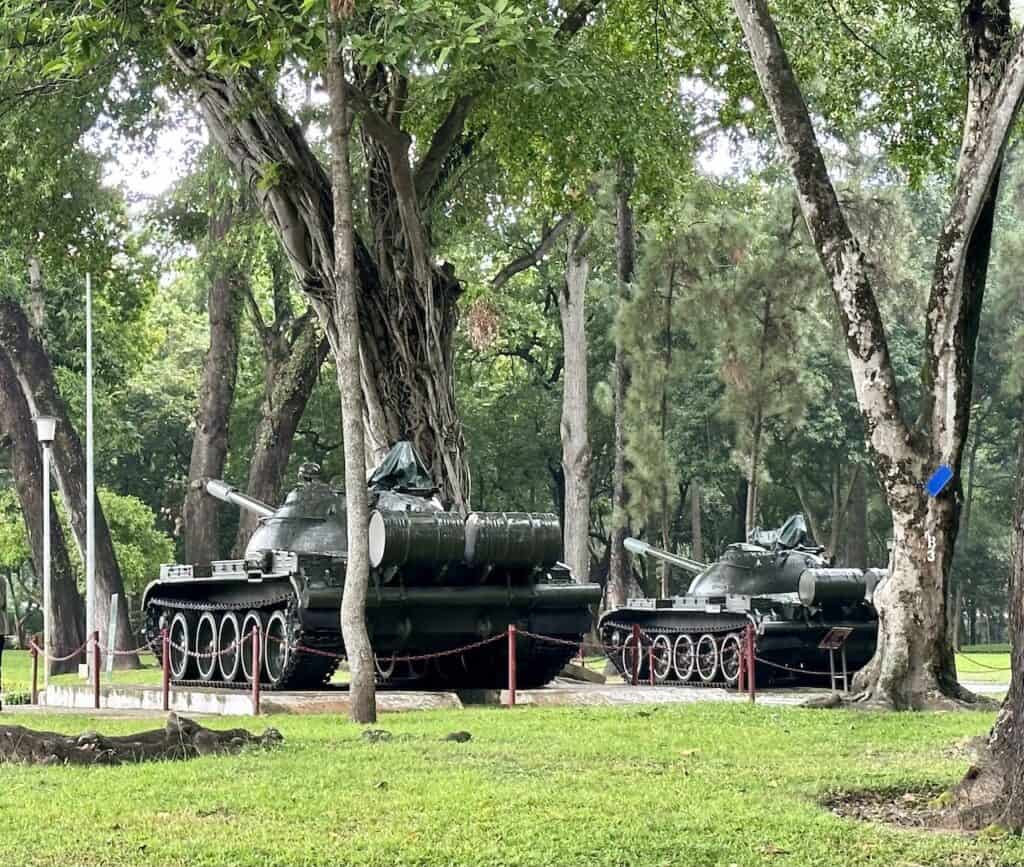
Walking Tour Stop #2: The War Remnants Museum
- Cost: 40,000 VD (about $2 USD)
- Cash-Only
- Hours: Daily 7:30 am – 5:00 pm
- Website: Click here
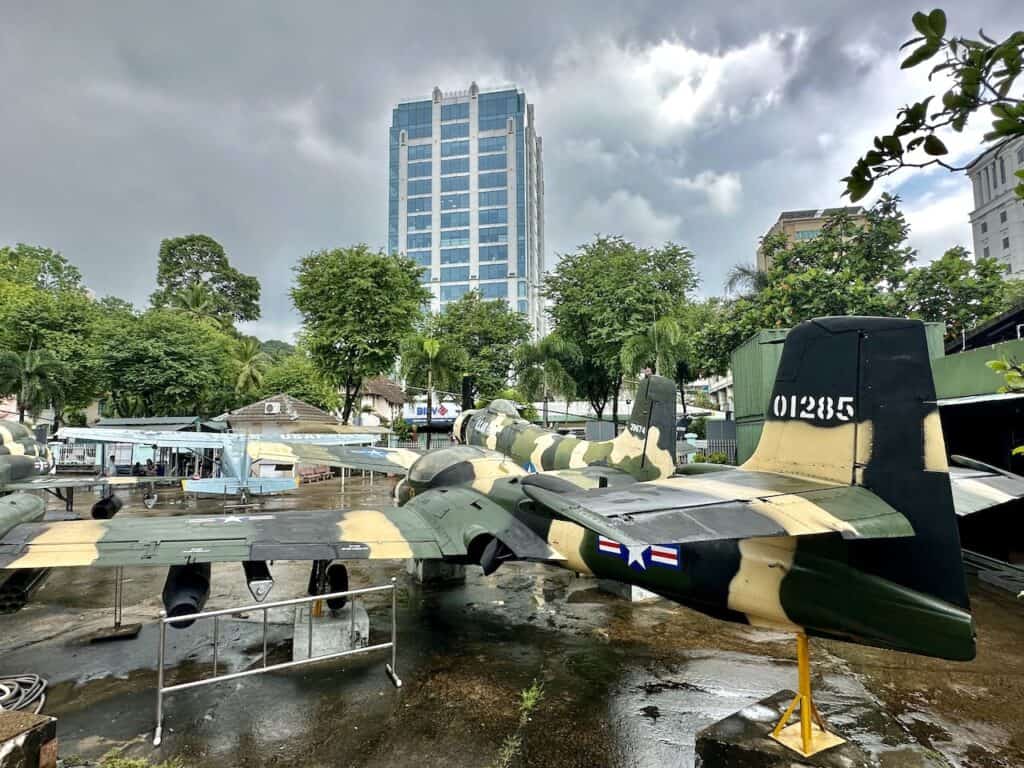
The War Remnants Museum bills itself as “a museum for peace.” It presents a perspective on the Vietnam War that aligns with the Vietnamese government’s point of view. Visitors should be prepared for graphic and sometimes distressing images and stories related to the war.
Visiting the museum can be a somber and reflective experience, offering insights into the human cost of the Vietnam War. Still, large parts of the museum are devoted to peace and reconciliation.
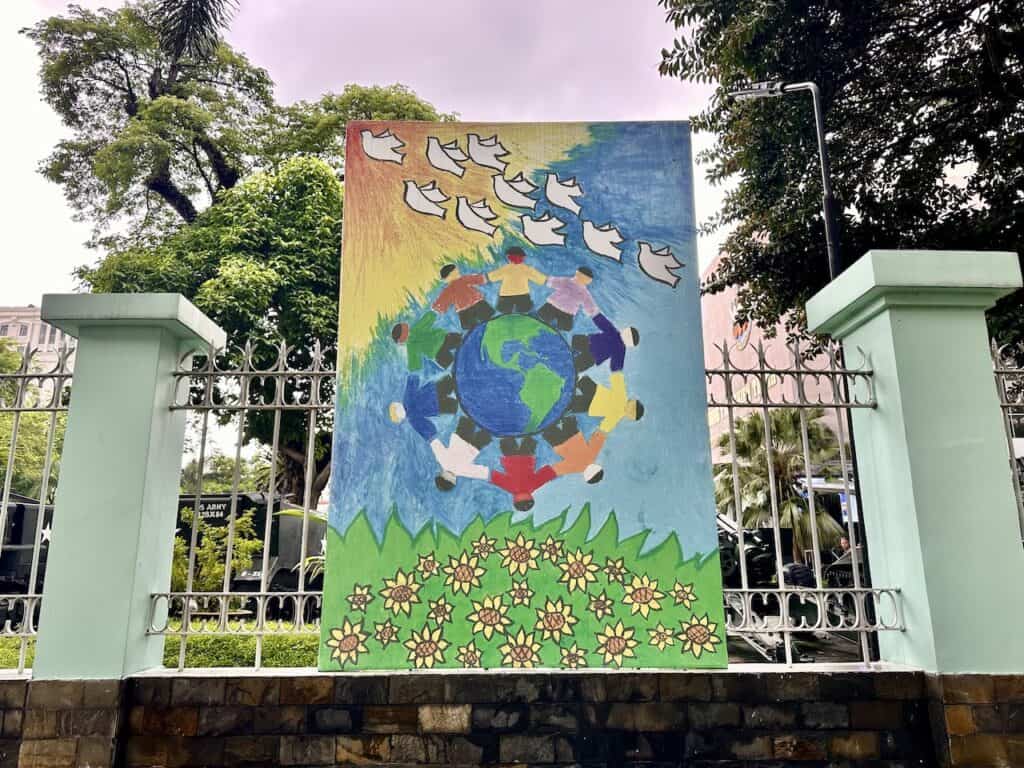
Here’s what you can expect to see and learn at the War Remnants Museum:
Historical Exhibitions: The museum features a collection of photographs, documents, and artifacts that provide a comprehensive overview of the Vietnam War. These exhibitions are divided into several sections, including:
- Photographs: Powerful and sometimes graphic photographs documenting the war’s impact on the Vietnamese people and the experiences of soldiers.
- War Crimes: Exhibits that shed light on the atrocities committed during the war, including the use of Agent Orange and other chemical weapons.
- Military Equipment: Displays of various military equipment, such as tanks, helicopters, and artillery pieces used during the conflict.
- Exhibits on Agent Orange: There are detailed exhibits on the devastating effects of Agent Orange, a herbicide used by the U.S. military during the war.
- Recreation of Prison Cells: The museum has recreated the prison cells used during the war, providing a glimpse into the harsh conditions endured by prisoners of war.
- Reconciliation and Post-War Efforts: Some exhibits focus on post-war reconciliation efforts and the process of rebuilding Vietnam after the conflict.
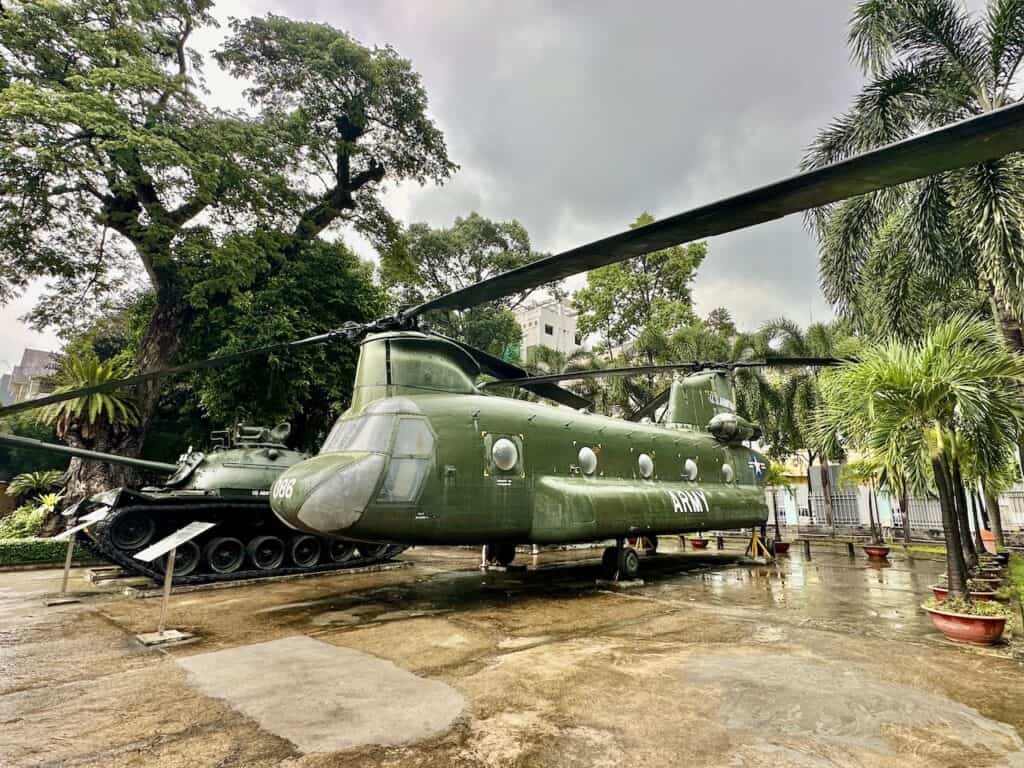
Here’s an incomplete list of the tanks, planes, and artillery displayed at the War Remnants Museum:
- M-48 Tank (one of 370 used in the Vietnam War)
- M-41 Tank
- M-132 Tank (flame-thrower)
- M-107 (“King of the Battlefield”)
- D-7E Bulldozer (one of 1,400)
- CH-47 Chinook Helicopter (for troop movement and supply missions)
- Huey Helicopter (for scouting and medical missions)
- Howitzers
- A-37 Bomber
- Cessna I-17 (reconnaissance)
- A-1 Sky Raider (bomber)
Walking Tour Stop # 3: Notre Dame
The Notre Dame Cathedral in Ho Chi Minh City is a short walk from the War Remnants Museum. It’s been closed for renovations for years, but still opens for church services (mass).
- Location: Saigon Notre Dame Cathedral, Ben Nghe
- Cost: Free
- Temporarily Closed (aside from mass)
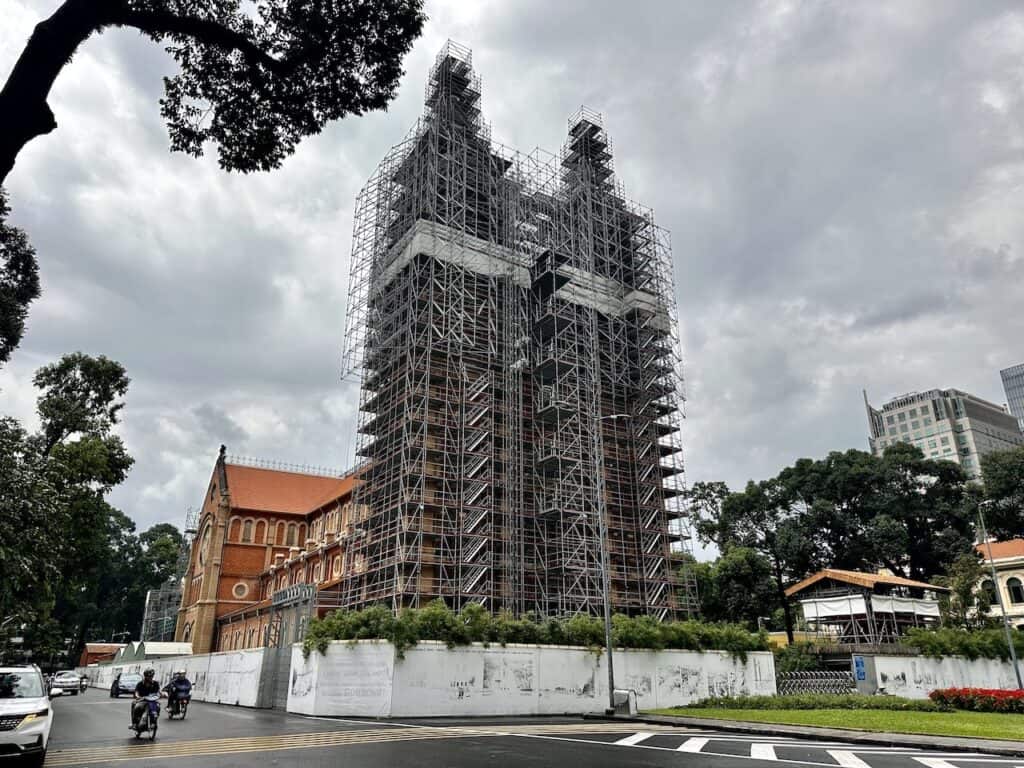
The Notre-Dame Cathedral Basilica of Saigon, often referred to simply as Saigon Notre-Dame Cathedral, is one of the most iconic landmarks in Ho Chi Minh City.
Here are the basics:
- The cathedral was constructed by the French during their colonial rule in Vietnam and bears a resemblance to the Notre Dame Cathedral in Paris.
- Construction of the cathedral began in 1863 and was completed in 1880. All of the original building materials, including the bricks, were imported from France.
- Inside the cathedral, you can find beautiful stained glass windows that depict various religious scenes.
- You may remember: several years ago, flocks of the faithful gathered around the statue of the Virgin Mary in front of the cathedral, after reports of tears coming from her eyes.
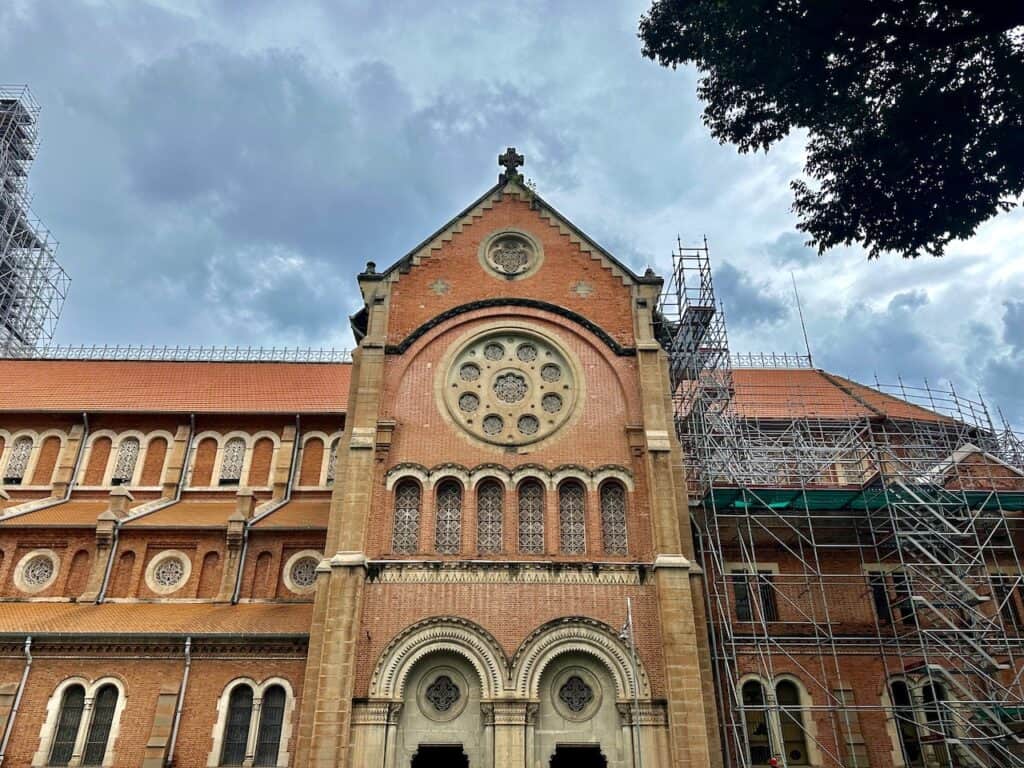
Walking Tour Stop #4: Central Post Office
Saigon’s Central Post Office is across the street from the cathedral. It’s still a functional post office, and also a historical and architectural landmark.
- Cost: Free
- Hours: Daily 7:30 am – 6:00 pm
- Website: Click here
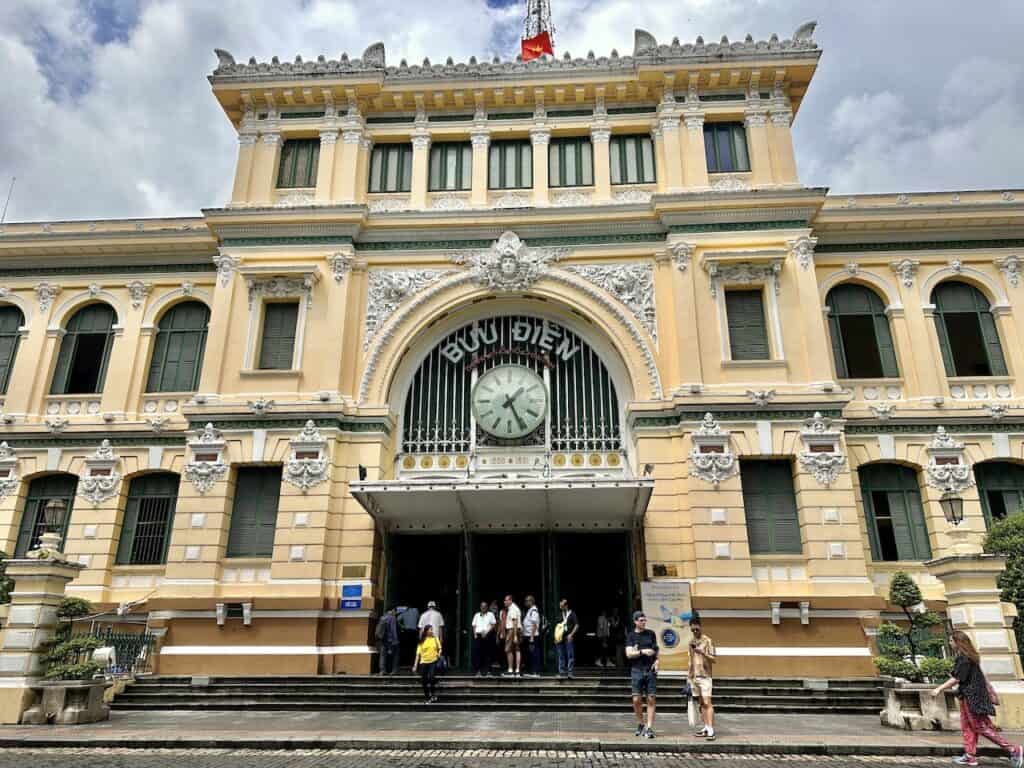
The Central Post Office is an example of French colonial architecture, featuring a blend of Gothic, Renaissance, and French architectural elements.
Saigon’s Central Post Office was designed by Gustave Eiffel, the French architect known for the Eiffel Tower in Paris.
It has been in continuous operation as a post office since its opening. Inside, visitors are greeted by a spacious, high-ceilinged hall with ornate details. The large portrait of Ho Chi Minh, Vietnam’s founding father, is prominently displayed inside.
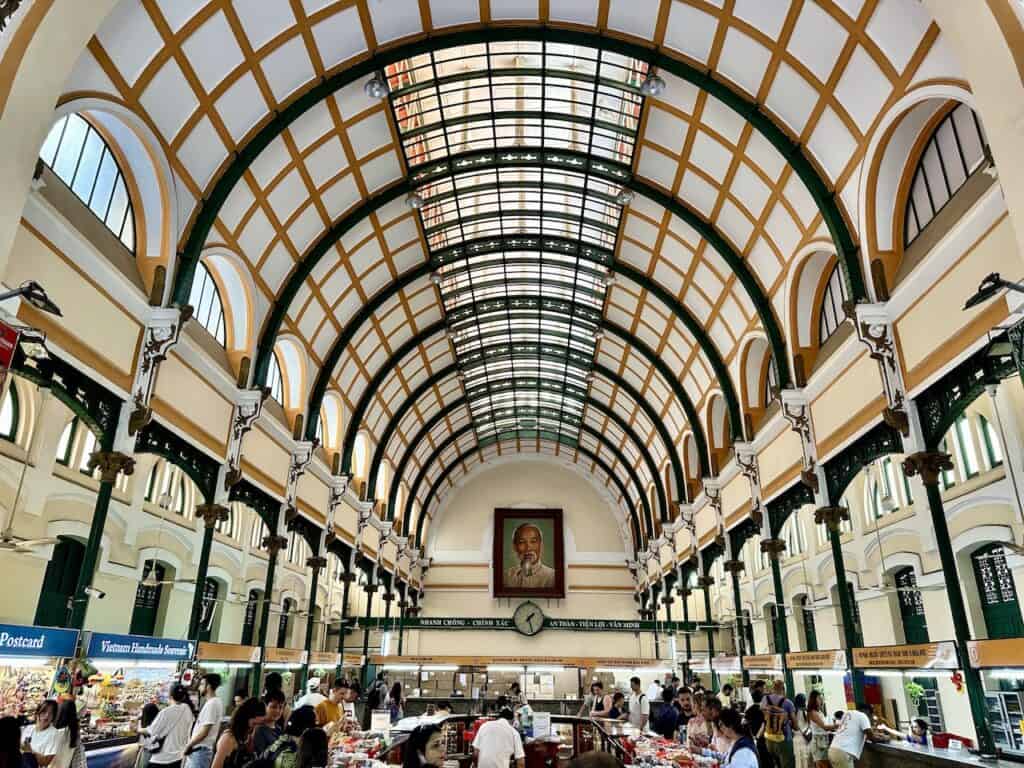
In addition to a post office, today the complex is mainly for tourists. There are several tour guide offices operating here, and the post office building is full of touristy shops.
Walking Tour Stop #5: Book Street
Book Street is right next to the Central Post Office, and is a vibrant street, full of … you guessed it: small book shops!
- Location: Intersection of Nguyen Van Binh & Nguyen Thi Minh Khai Streets
- Cost: Free
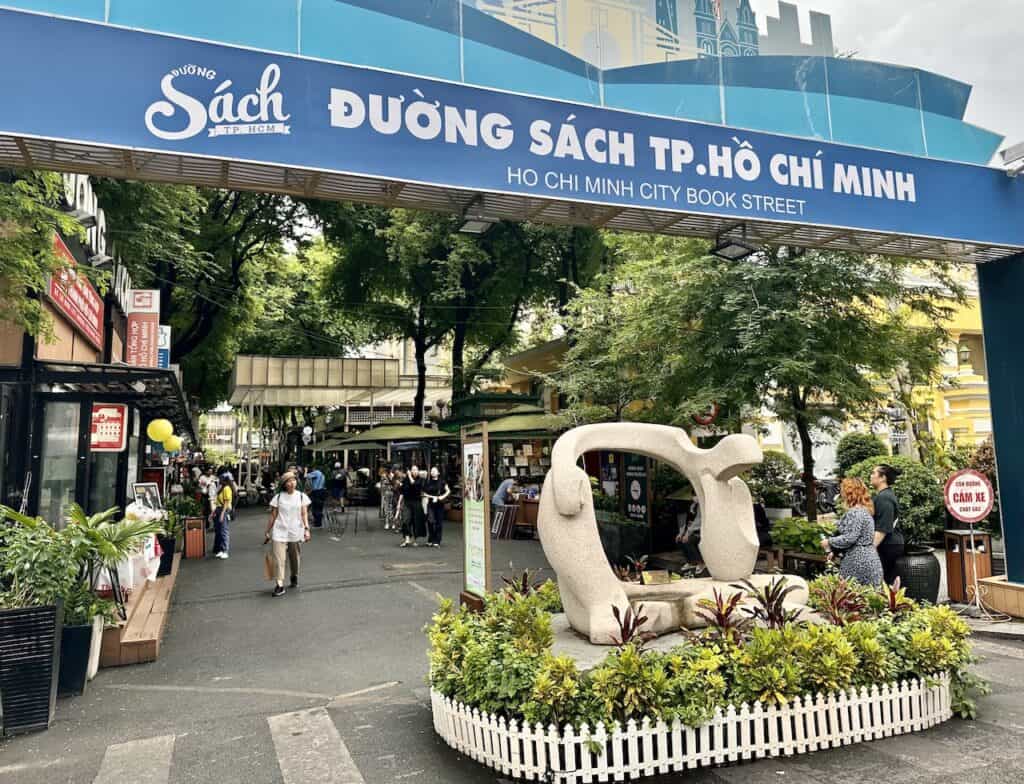
“Book Street” is known locally as “Đường Sách” or “Nguyen Van Binh Street.” The street is often designated as a pedestrian-only zone on weekends and during special events.
You can find a wide range of books, on literature, history, art, children’s stories, and more.
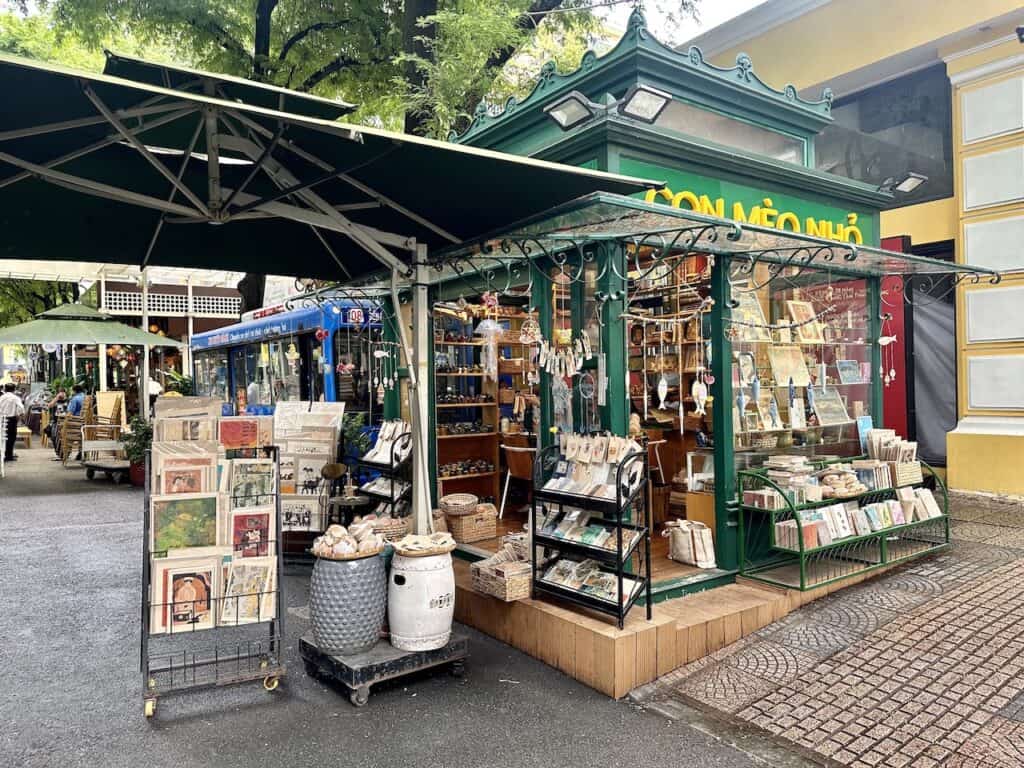
In addition to bookstores, there are numerous cafes and restaurants along Book Street, which often hosts outdoor events, book launches, and author signings.
You’re also likely to find artists painting and sketching, along with a few souvenir shops, too.
Book Street is a great place to escape the sun (or a rain shower) under the thick canopy of trees above.
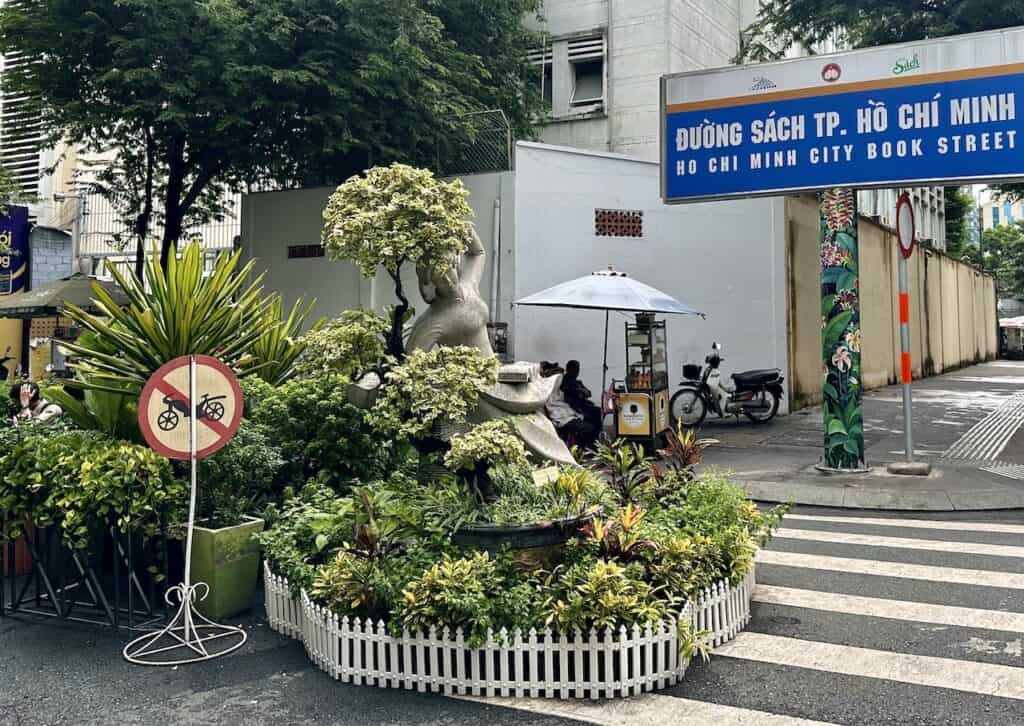
Walking Tour Stop #6: Last Mission Landing Zone
This stop on our tour isn’t on the map.
I was determined to find the location of the famous photo, showing the helicopter evacuation from a Saigon rooftop at the end of the war. It’s close to the Central Post Office, but unless you’re looking for it … you’d never spot it.
- Location: 22 Lý Tự Trọng
- Hours: Not open to the public
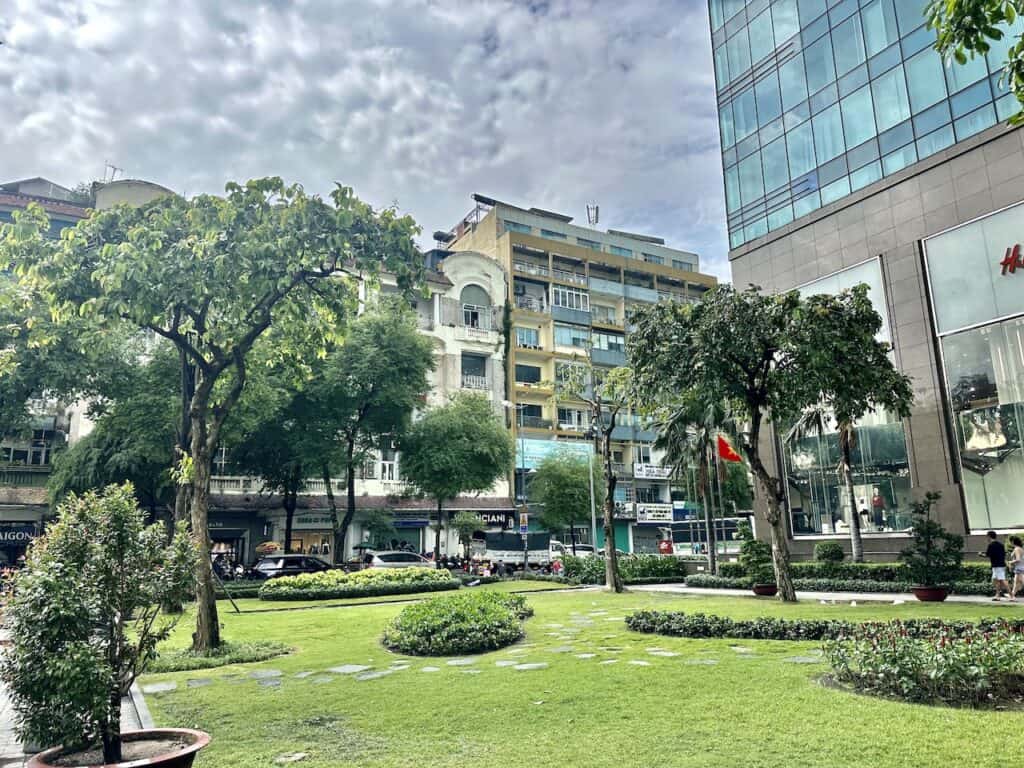
During the fall of Saigon in 1975, the photograph shows a U.S. Marine assisting evacuees, including Vietnamese civilians and U.S. Embassy personnel, onto a helicopter on the rooftop of a building in Saigon.
By April, as North Vietnamese forces closed in on the city, the U.S. Embassy became a focal point for evacuation efforts. Helicopters were used to airlift people from the embassy and other locations.
The most famous photograph was taken by Hugh Van Es, a Dutch photojournalist who was working for United Press International (UPI) at the time. His image came to symbolize the war’s end.
The building wasn’t part of the consulate or embassy, but rather an apartment building.
Today, it’s unmarked and across from a gleaming new shopping mall. In this photo, it’s the yellow building in the center:
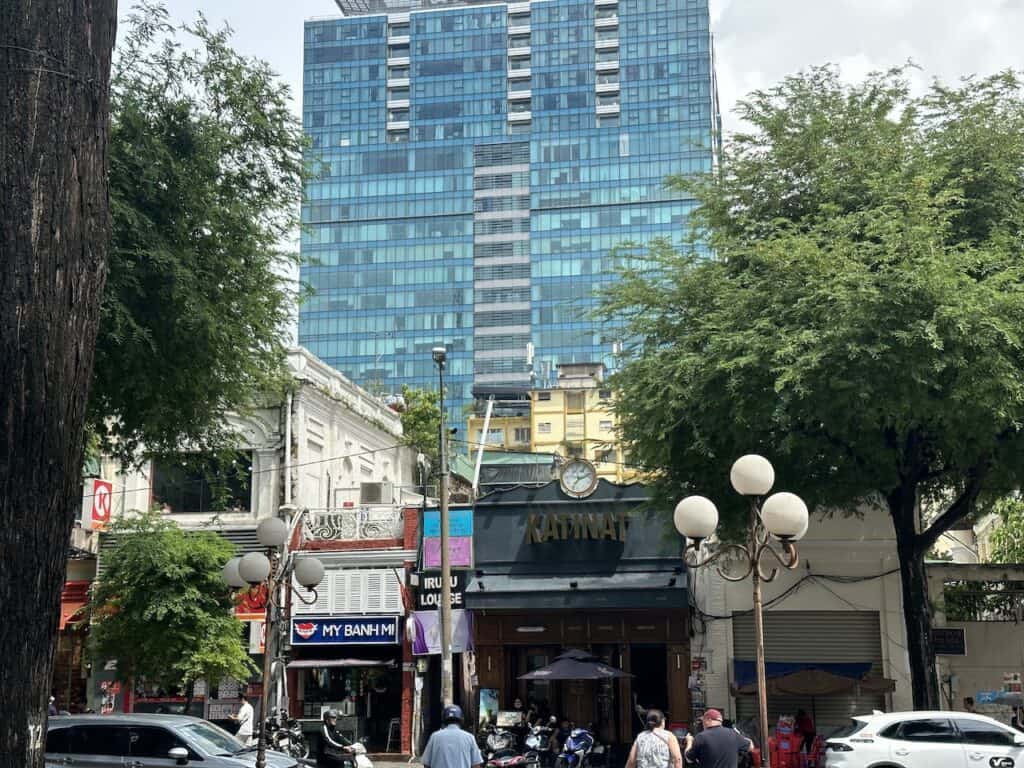
If you step back, you can make out the words “The Landing Zone” and “The Last Mission” painted on the building’s rooftop. It was apparently a restaurant or bar for some time, but it’s since closed.
We tried to get inside a few different ways, but were turned back. I’ve heard you can pay whomever you find at the door for access, so it may be worth a try on your visit.
Walking Tour Stop # 7: Art Arcade
If you haven’t had enough shopping along your walking tour of Saigon, consider stopping in the Art Arcade. It’s a gathering of local art and artists.
- Location: 151 Đ. Đồng Khởi, Bến Nghé, Quận 1, Thành phố Hồ Chí Minh, Vietnam
I’m really just adding the Art Arcade as an example of the interesting shops you’ll come across on your walk around Ho Chi Minh City.
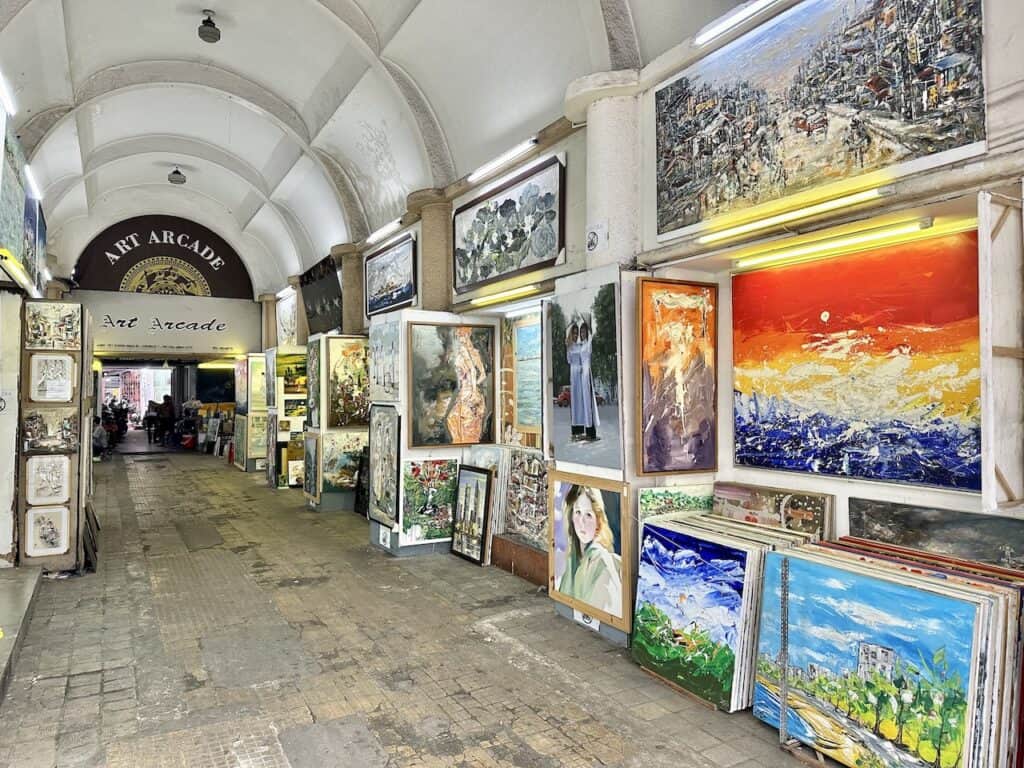
Walking Tour Stop # 8: Ben Thanh Market
The Ben Thanh Market is one of the most famous and most crowded places you’ll find in Saigon. It’s definitely worth a stop on a walking tour of Ho Chi Minh City.
- Location: Ben Thanh, District 1, Ho Chi Minh City, Vietnam
- Cost: Free
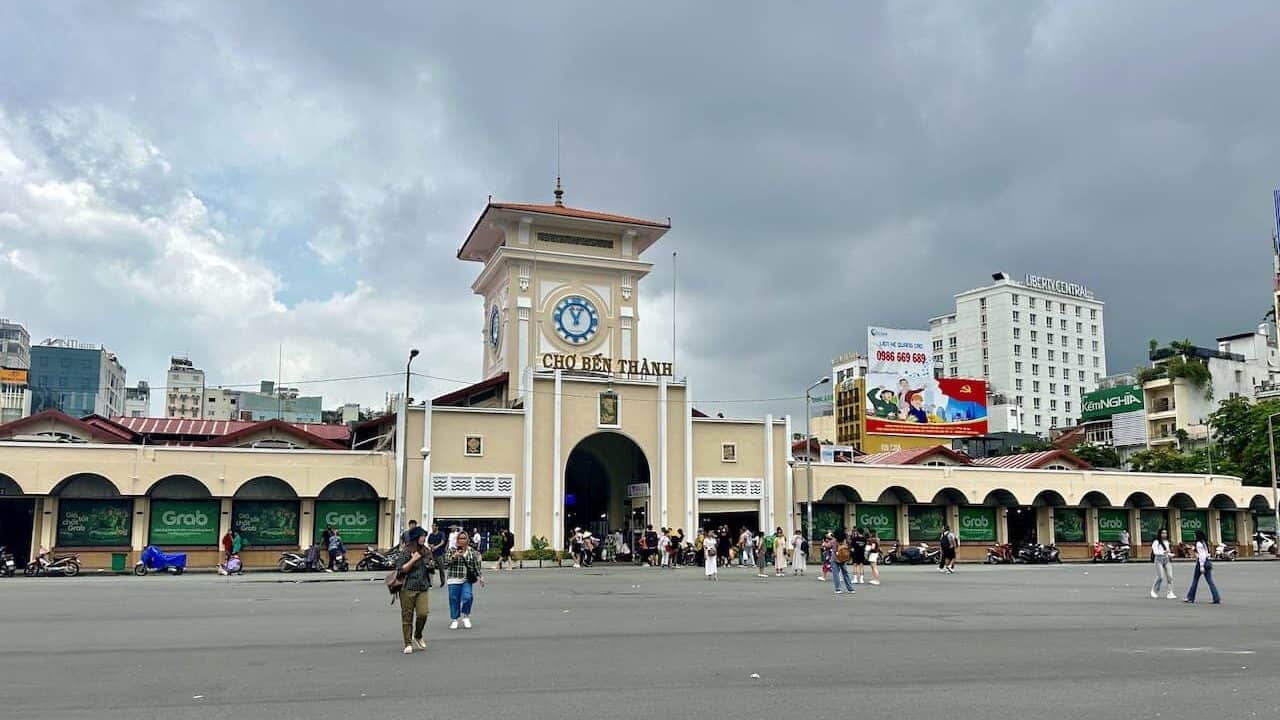
Ben Thanh Market is a popular destination for tourists, but also a bustling hub for locals. You’ll find it at the intersection of Le Loi, Ham Nghi, Le Lai, and Tran Hung Dao streets.
The market has a long history dating back to the French colonial era when it was originally established by the French colonial government. It underwent renovations and expansions over the years and has become an enduring symbol of the city.
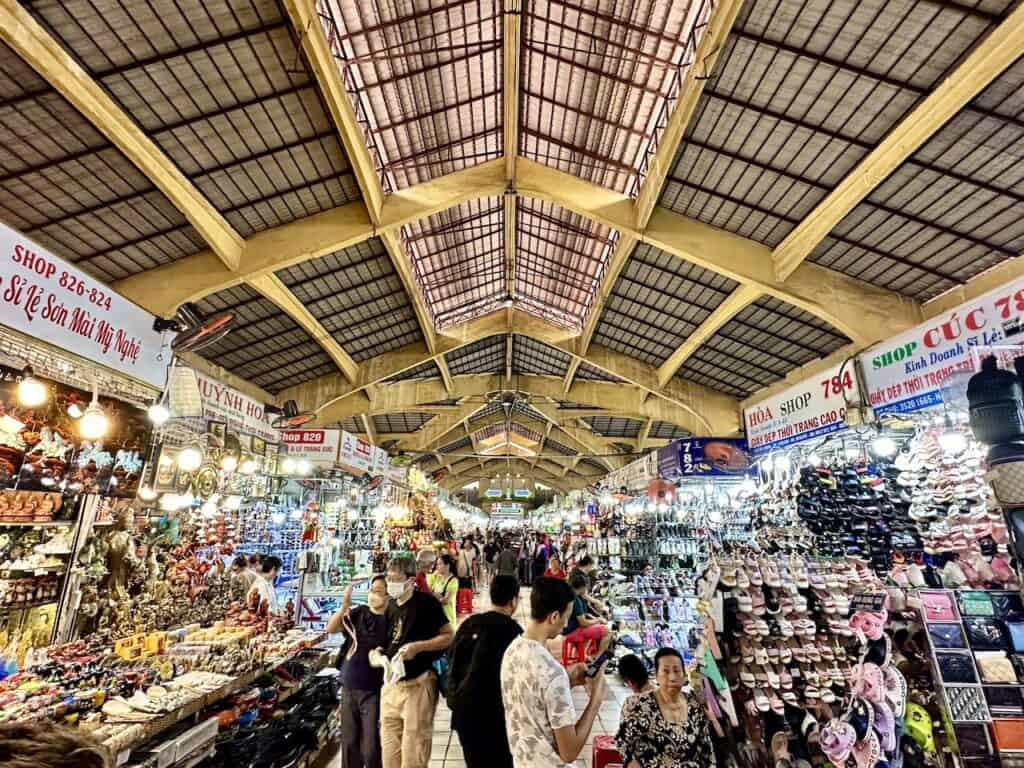
The market is easy to spot, with its distinctive yellow, clock-towered building. It’s surrounded by motorbikes coming and going, so be careful crossing in!
You can shop for a wide range of goods, including clothing, textiles, jewelry, handicrafts, accessories, home goods, and souvenirs. It’s a great place to find traditional Vietnamese clothing like ao dai, silk products, lacquerware, and snacks.
Bargaining is a common practice at Ben Thanh Market. Prices are often marked up initially, so negotiating with the vendors is expected. Their first price is typically double what they’re willing to accept.
Walking Tour Stop #9: Saigon’s Riverfront
While the Saigon Riverfront may not have as many specific attractions to check out, it offers picturesque views of the Saigon River, which winds its way through the city.
There are several riverfront parks and green spaces where you can relax and enjoy the fresh air. Some popular parks along the river include Le Van Tam Park and Bach Dang Park, which are great for picnics and outdoor activities.
The riverfront area is also dotted with cultural and historical sites, including temples and pagodas, such as the Jade Emperor Pagoda and the Khanh Van Nam Vien Pagoda.
Many cafes and restaurants line the riverfront, offering an opportunity to enjoy a meal or drinks with a view.
24 Hours in Saigon: Top Sites to See
Here are some of the other top tourist attractions in (and around) Ho Chi Minh City, which you could add to your walking tour:
- Saigon Opera House: Also known as the Municipal Theater, this beautifully preserved building hosts cultural performances, including ballet, classical music, and opera.
- Giac Lam Pagoda: This is one of the oldest pagodas in the city, known for its beautiful gardens, ancient relics, and a 32-meter-tall stupa.
- Saigon Skydeck at Bitexco Financial Tower: For panoramic views of the city, visit the Saigon Skydeck. It’s one of the tallest buildings in Ho Chi Minh City and offers breathtaking vistas.
- Ho Chi Minh City Museum: Located in the city center, this museum showcases the history and culture of Saigon and its people.
- Ho Chi Minh City Zoo and Botanical Gardens: A family-friendly attraction, this zoo features a variety of animals and lush greenery.
Other Things to Do Near Saigon
A few other top attractions around Ho Chi Minh City will require more time. If you have more than 24 hours in Saigon, it’s worth checking these out:
- Cu Chi Tunnels: Although located a bit outside the city, a visit to the Cu Chi Tunnels is a must for history enthusiasts. These tunnels were used by the Viet Cong during the Vietnam War, and you can explore a portion of them.
- Jade Emperor Pagoda (Phước Hải Tu): This atmospheric Taoist temple is a serene escape from the city’s hustle and bustle. It features intricate architecture and statues.
- Saigon River Cruises: You can take a scenic cruise along the Saigon River, which offers a different perspective of the city’s skyline.
- Mekong Delta Day Tours: While not in the city itself, many tourists take day trips to explore the Mekong Delta, a picturesque region known for its floating markets, lush landscapes, and river life.
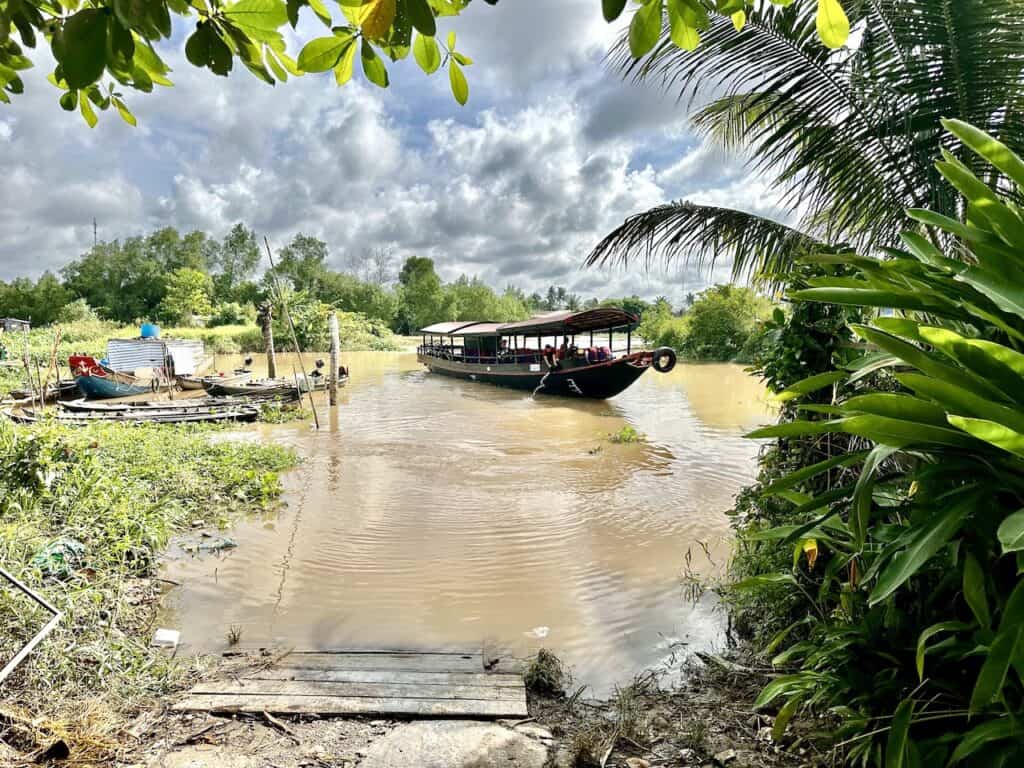
Is Saigon Safe?
Saigon is definitely a safe city, but keep these three things in mind to make sure you enjoy your self-guided walking tour!
- Be mindful of traffic: Saigon’s streets can be crowded and chaotic, so always exercise caution when crossing roads.
- Stay hydrated: Saigon’s climate can be hot and humid, so carry water with you to stay hydrated during your walk.
- Bring an umbrella or poncho: The rainy season lasts from the spring through the summer into the fall months, and showers come and go all day.
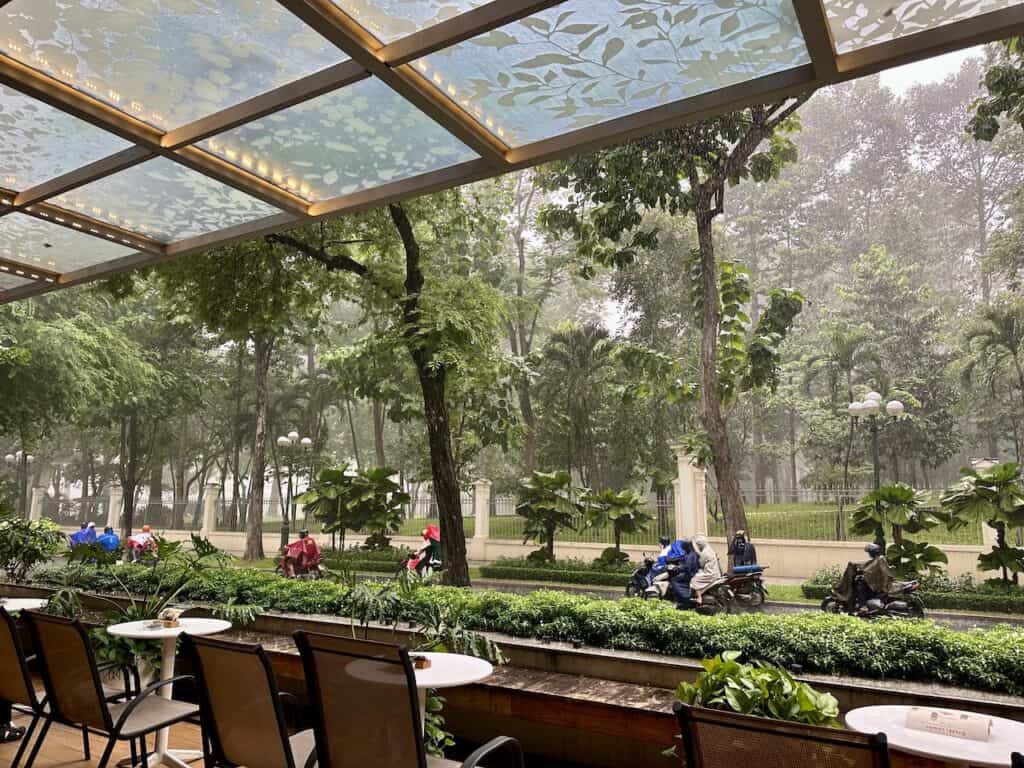
PRO TIP: There are many taxi companies serving the Saigon area, but ViNaSun is widely considered by locals to be the most consistent and trustworthy when it comes to meter prices.
Ho Chi Minh City Walking Tour FAQs
Let’s tackle a few more frequently asked questions about taking a walking tour in Saigon, and visiting the city in general.
Is it Saigon or Ho Chi Minh City?
Saigon officially changed its name to Ho Chi Minh City on April 30, 1975. This change occurred as a result of the fall of Saigon to North Vietnamese forces during the Vietnam War. The city was renamed to honor Ho Chi Minh, the communist leader who played a key role in the struggle for Vietnamese independence from French colonial rule and who later became the first president of North Vietnam.
Today, the names can be used interchangeably, though locals refer to District 1 (the touristy city center) as “Saigon.”
Neither is considered inappropriate or offensive in Vietnam.
What is the Ho Chi Minh City airport code?
The airport code for Tan Son Nhat International Airport is “SGN.”
How much is a taxi to SGN airport in Saigon?
From the touristy area, District 1, it will cost $10 – $15 USD for a taxi to the airport. Without traffic, the ride might only take 20 minutes, but you should prepare for your ride to take much longer.
Is Ho Chi Minh City expensive?
The US Dollar and the Euro go far in Vietnam (and all of Southeast Asia).
Public transportation, such as buses and motorbike taxis, is relatively cheap in Saigon. Ride-sharing services like Grab are also affordable and convenient for getting around the city. Taxis are also affordable, and run about a quarter of the cost you’d pay in a typical American city.
Meals are inexpensive, too. Many menu options which would cost $20 in the US cost about $5 in Saigon.
Plus, as I mentioned earlier, many of Ho Chi Minh’s top attractions, from museums to cultural sites, have low or no entrance fees.
Wrap: Is a Walking Tour of Saigon Worth It?
Ultimately, whether spending 24 hours in Saigon is worth it depends on your travel goals. While it’s not possible to explore the city in its entirety in such a short time, you can still have a meaningful and enjoyable experience by focusing on specific attractions and activities that align with your interests.
Here are some factors to consider when deciding whether a 24-hour stay in Saigon is worth it:
- Time Constraints: If you have only 24 hours to spare in the city due to a layover or a tight travel schedule, it’s definitely worth making the most of your time. You can still explore some of the city’s highlights and get a taste of its culture.
- Key Attractions: Ho Chi Minh City offers several iconic attractions that you can visit in a day, including the War Remnants Museum, Notre-Dame Cathedral, Independence Palace, and Ben Thanh Market.
- Local Cuisine: Saigon is renowned for its delicious street food and local cuisine. Don’t miss the opportunity to try dishes like pho, banh mi, and fresh spring rolls at local restaurants.
- Nightlife: Saigon has a lively nightlife scene with rooftop bars, nightclubs, and street-side bars where you can unwind and enjoy the city’s nightlife.
